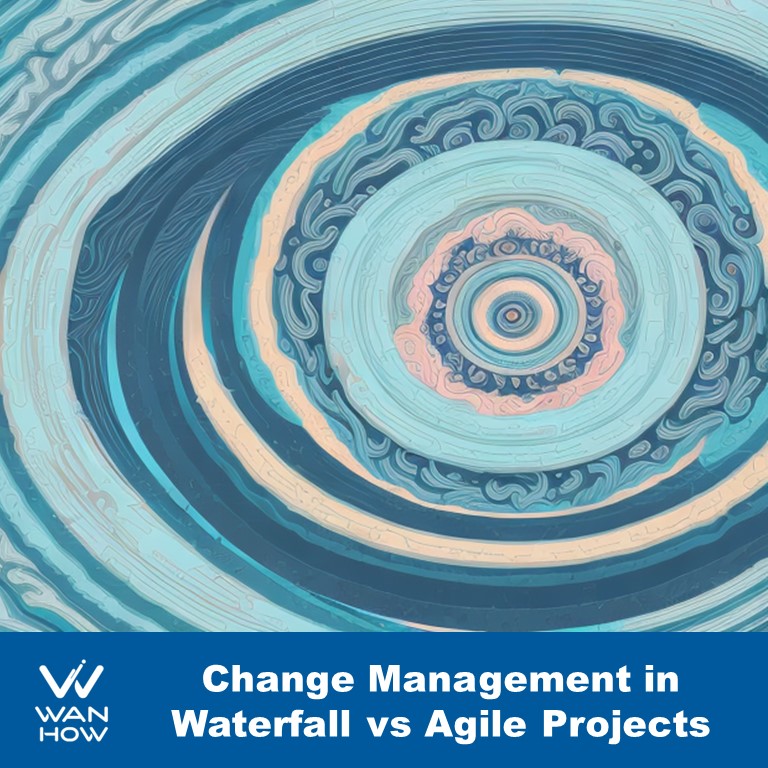
Change management is a crucial aspect of project management that ensures smooth transitions and successful outcomes. First, let’s start with some definitions:
- Organizational change management is the process of preparing, supporting, and helping individuals, teams, and organizations in making organizational change. It is usually the purview of the Human Resources Department.
- Project change management is about altering the scope, schedule, budget, and other details of the project.
There is some overlap between project and organizational change management. When the impact on people is minimal, project managers can manage the people-side of change as part of the scope of the project. When the impact on people is significant, then HR needs to lead organizational change management. This post focuses mainly on project change management. In terms of impact on people, the focus is on managing stakeholders and helping them move through the change curve in order to deliver a successful project outcome.
The approach to change management varies significantly between waterfall and agile projects. This blog post will delve into the intricacies of change management in both methodologies, highlighting their differences, strengths, and weaknesses.
Understanding Waterfall and Agile Methodologies
Waterfall Methodology
The waterfall model is a linear and sequential approach to project management. It is characterized by a rigid structure where each phase of the project must be completed before the next one begins. This method is often used in projects where requirements are well-defined and unlikely to change.
Change management in a waterfall project can be quite challenging due to its inflexible nature. Changes are usually costly and time-consuming as they may require revisiting and altering completed stages of the project.
Agile Methodology
Contrary to the waterfall model, the agile methodology is an iterative and flexible approach to project management. It is characterized by its adaptability and responsiveness to change. Agile projects are broken down into several iterations or sprints, allowing for continuous improvement and adaptation.
Change management in an agile project is more straightforward due to its inherent flexibility. Changes can be implemented at the end of each sprint, making it easier to adapt to new requirements or unexpected situations.
Change Management in Waterfall Projects
Planning and Documentation
In waterfall projects, change management requires meticulous planning and documentation. Any proposed changes must be thoroughly analyzed for their impact on the project’s scope, timeline, and budget. A formal change request is usually required, detailing the proposed change, the reasons for it, and its potential impact.
Once the change request is approved, the project plan and documentation must be updated accordingly. This can be a time-consuming process, but it ensures that all stakeholders are on the same page and that the project remains on track.
Resistance to Change
Due to the rigid structure of waterfall projects, there can often be resistance to change. Stakeholders may be reluctant to alter the project’s scope or timeline, especially if the project is already underway. Overcoming this resistance requires strong leadership and clear communication about the benefits of the proposed change.
Change management in waterfall projects often involves a significant amount of negotiation and persuasion. It is crucial to demonstrate that the proposed change will lead to a better outcome for the project and the organization as a whole.
Change Management in Agile Projects
Embracing Change
In agile projects, change is not only expected but also welcomed. The agile methodology is designed to be adaptable, allowing for continuous improvement and adaptation. Changes can be implemented at the end of each sprint, making it easier to respond to new requirements or unforeseen circumstances.
Change management in agile projects involves regularly reviewing and adjusting the project’s direction. This iterative approach allows for continuous learning and improvement, leading to a better final product.
Collaboration and Communication
Change management in agile projects is a collaborative process. The project team, stakeholders, and customers are all involved in reviewing and approving changes. This collaborative approach ensures that all perspectives are considered and that the best decisions are made for the project.
Effective communication is also crucial in agile change management. Regular meetings and updates keep everyone informed about the project’s progress and any changes that are being made. This transparency helps to build trust and ensures that everyone is working towards the same goal.
Conclusion
Change management plays a vital role in the success of any project, regardless of the methodology used. While the approach to change management differs between waterfall and agile projects, the goal remains the same: to ensure that changes are implemented smoothly and effectively, leading to a successful project outcome.
Whether you’re managing a waterfall or agile project, it’s crucial to understand the nuances of change management in your chosen methodology. By doing so, you can navigate changes more effectively and lead your project to success.
